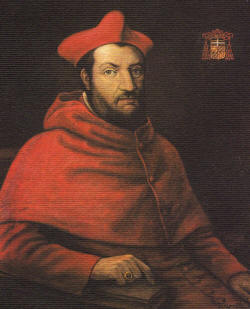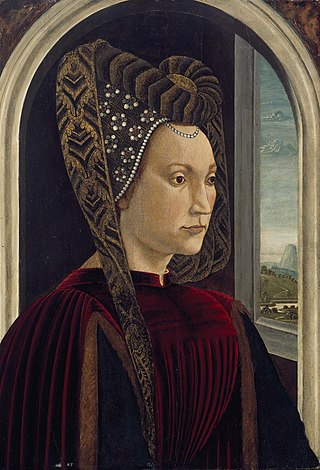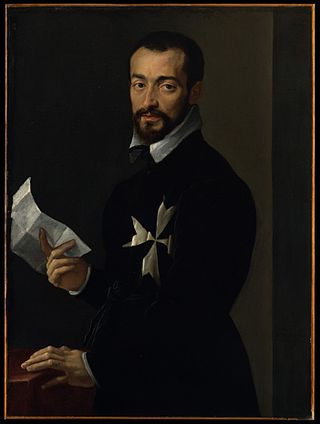This article needs additional citations for verification .(May 2023) |
| Salviati | |
|---|---|
 | |
| Current region | Tuscany |
| Members |
|

The Salviati family is a historical Italian noble family, rooted in the Republic of Florence. [1]
This article needs additional citations for verification .(May 2023) |
| Salviati | |
|---|---|
 | |
| Current region | Tuscany |
| Members |
|

The Salviati family is a historical Italian noble family, rooted in the Republic of Florence. [1]
Some sources would trace the Salviati family back to a progenitor named Gottifredo who lived in the 12th century , but the first historically ascertained figure member of the family was Cambio di Salvi, who occupied both positions of gonfalonieri and priori . After him, there were twenty Salviati members who were gonfalonieri and sixty-two who occupied the position of priori.

Lorenzo di Piero de' Medici, known as Lorenzo the Magnificent, was an Italian statesman, the de facto ruler of the Florentine Republic, and the most powerful patron of Renaissance culture in Italy. Lorenzo held the balance of power within the Italic League, an alliance of states that stabilized political conditions on the Italian Peninsula for decades, and his life coincided with the mature phase of the Italian Renaissance and the golden age of Florence. As a patron, he is best known for his sponsorship of artists such as Botticelli and Michelangelo. On the foreign policy front, Lorenzo manifested a clear plan to stem the territorial ambitions of Pope Sixtus IV, in the name of the balance of the Italian League of 1454. For these reasons, Lorenzo was the subject of the Pazzi conspiracy (1478), in which his brother Giuliano was assassinated. The Peace of Lodi of 1454 that he supported among the various Italian states collapsed with his death. He is buried in the Medici Chapel in Florence.

The Pazzi were a powerful family in the Republic of Florence. Their main trade during the fifteenth century was banking. In the aftermath of the Pazzi conspiracy in 1478, members of the family were banished from Florence and their property was confiscated; the family name and coat-of-arms were permanently suppressed by order of the Signoria.

Cosimo I de' Medici was the second duke of Florence from 1537 until 1569, when he became the first grand duke of Tuscany, a title he held until his death.

The Pazzi conspiracy was a failed plot by members of the Pazzi family and others to displace the Medici family as rulers of Renaissance Florence.

Lucrezia de' Medici was the name for several women from the Medici family:

San Marco is a religious complex in Florence, Italy. It comprises a church and a convent. The convent, which is now the Museo Nazionale di San Marco, has three claims to fame. During the 15th century it was home to two famous Dominicans, the painter Fra Angelico and the preacher Girolamo Savonarola. Furthermore, the church houses the tomb of Pico Della Mirandola, a Renaissance philosopher and the so called "Father of Humanism."

Giovanni Salviati was a Florentine diplomat and cardinal. He was papal legate in France, and conducted negotiations with the Emperor Charles V.

Lucrezia de' Medici was a member of the House of Medici and by marriage Duchess consort of Ferrara, Modena and Reggio from 1558 to 1561.

Bernardo Salviati was an Italian condottiero and Roman Catholic Cardinal.

Antonio Maria Salviati was a Florentine Roman Catholic cardinal.

Clarice Orsini (1453–1488) was the daughter of Jacopo Orsini, and his wife and cousin Maddalena Orsini both from the Orsini family, a great Roman noble house and was the wife of Lorenzo de' Medici.

Filippo Vincenzo Romolo Salviati was an Italian nobleman, scientist and friend of Galileo. He is remembered today mainly because he appears as one of the figures in Galileo's controversial work the Dialogue Concerning the Two Chief World Systems (1632).

Lucrezia Maria Romola de' Medici was an Italian noblewoman, the eldest daughter of Lorenzo de' Medici and Clarice Orsini and mother of Maria Salviati and Giovanni Salviati. Her portrait was considered as the baby Jesus in Our Lady of the Magnificat of Sandro Botticelli.

Lucrezia "Nannina" de' Medici, sometimes known by the longer name Lucrezia di Piero de' Medici including a patronymic, was the second daughter of Piero di Cosimo de' Medici and Lucrezia Tornabuoni. She was thus the elder sister of Lorenzo de' Medici. She married Bernardo Rucellai.

Jacopo Salviati was a Florentine politician and son-in-law of Lorenzo de' Medici. On 10 September 1486 he married Lorenzo's daughter Lucrezia de' Medici, with whom he had ten children. The son of Giovanni Salviati and Maddalena Gondi, he devoted himself to the economic affairs of the family, becoming very wealthy. He then engaged in political life. He was Prior of the Guilds of Florence in 1499 and 1518, then gonfaloniere of Justice in 1514. In 1513, he was appointed ambassador to Rome.

Innocenzo Cibo was an Italian cardinal and archbishop.

Bernardo Rucellai, also known as Bernardo di Giovanni Rucellai or Latinised as Bernardus Oricellarius, was a member of the Florentine political and social elite. He was the son of Giovanni di Paolo Rucellai (1403–1481) and father of Giovanni di Bernardo Rucellai (1475–1525). He was married to Nannina de' Medici, the elder sister of Lorenzo de' Medici, and was thus uncle to Popes Leo X and Clement VII, who were cousins. Oligarch, banker, ambassador and man of letters, he is today remembered principally for the meetings of the members of the Accademia Platonica in the Orti Oricellari, the gardens of his house in Florence, the Palazzo Rucellai, where Niccolò Machiavelli gave readings of his Discorsi.

Giovanni Rucellai, known as Giovanni di Bernardo Rucellai, was an Italian humanist, poet, dramatist and man of letters in Renaissance Florence, in Tuscany, Italy. A member of a wealthy family of wool merchants and one of the richest men in Florence, he was cousin to Pope Leo X and linked by marriage to the powerful Strozzi and de' Medici families. He was born in Florence, and died in Rome. He was the son of Bernardo Rucellai (1448–1514) and his wife Nannina de' Medici (1448–1493), and the grandson of Giovanni di Paolo Rucellai (1403–1481). He is now remembered mostly for his poem Le Api, one of the first poems composed in versi sciolti to achieve widespread acclaim.

Gentile de' Becchi was an Italian bishop, diplomat, orator and writer. He was a member of the Platonic Academy of the Medici of Florence and tutor of Lorenzo the Magnificent and his son Giovanni de' Medici, later Pope Leo X. Of his writings there exist many letters, poems in Latin, and prayers which are praised by historian Cecil Grayson as his finest works.

Giovanni Corsi was a noble Italian Marquis, Knight, Patron, Ambassador and Senator of Florence in 1637. He was the second Marquis of Caiazzo, title he inherited after Bardo Corsi death in 1624.
![]() Media related to House of Salviati at Wikimedia Commons
Media related to House of Salviati at Wikimedia Commons